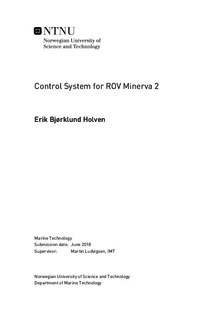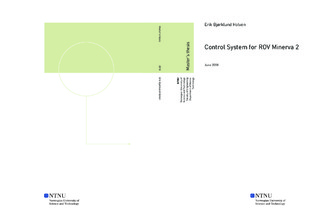| dc.description.abstract | This thesis cover the development of the motion control system for a Remotely Operated Vehicle (ROV). The Norwegian University of Science and Technology are receiving a new ROV, Minerva 2, which is the topic of this thesis. Three aspects of the ROV system is focused on in this thesis. This is: the mathematical modelling of the vessel, the control system of the ROV, and an evaluation of the feasibility of applying system identification to the ROV is considered.
The mathematical model of the ROV is derived by considering a 6 Degree Of Freedom(DOF) model for a marine vessel. The rigid body motion can be derived on the basis of the mass properties of the ROV. The hydrodynamic parameters have been established for the ROV, to account for the effect of the ROV being submerged in water. This is done by applying computational tools. The added mass is determined by using a tool based on potential theory and radiation and diffraction methodology. The damping on the ROV will be dominated by viscous effect, that are neglected in potential theory. For this reason Computational Fluid Dynamics (CFD) is applied to a model of the ROV, to determine the damping coefficients. The result was verified by considering a simple geometry reference object that was analysed both with computational tools and with empirical estimated. The result for the added mass gave results that are in accordance with expectations. For the damping, the linear term seem to have been underestimate, while the quadratic term of the damping function might be too large. An experimental test was designed to test a scale model of the ROV, and estimate the hydrodynamic parameters of the ROV experimentally. Problems in the experiment related to the sensor alignment and motions on the mounting bracket made introduced inaccuracies in the measurement. The calculated damping was found to be in the same order of magnitude as for the CFD analysis. Due to inaccuracies in the measurements, the quality of the data was not sufficiently good for the added mass to be calculated.
The control system is based on an existing control system developed for the former ROV's at NTNU. Since the new ROV is controlled in 6 DOF's, compared to 4 for the old ROV's, the controller have been expanded to account for roll and pitch motion. Minerva 2 is also an over actuated ROV, meaning that there are more thrusters than DOF's. This result in a system where there are infinitely many combinations of thruster speeds that can result in one desired output. A new thrust allocator was developed to determine the optimal combination of the thruster speeds corresponding to a desired output. This was done by defining an optimisation target of minimizing the total propulsion energy, and solving the thrust allocation problem as an optimisation problem. A secondary objective for the thrust allocator was to limit water from being flushed in front of the cameras, when it was possible to avoid it. This was achieved by giving energy associated to thrust causing water to be flushed in front of the ROV a large weight. Development have also been made in the autonomy part of the control system. The purpose of this was to allow for separate programs performing sonar and camera tracking, to relay this information to the autonomy system in form of way points. This was tested with a virtual integration of the ROV control system, in a simulation of an inspection mission.
A system identification function have also been evaluated. This involves calculating the mathematical model of the vessel based on the response of the ROV, i.e the motion of the ROV, and the control input. Both simple simulations and simulations using Hardware In the Loop (HIL) simulators was used to evaluate the feasibility of such a system. The result of these simulation showed promising result. These test show that with a sufficiently large sample of measurement, the system identification is able to create a mathematical model of the system, with a high level of accuracy. | |

